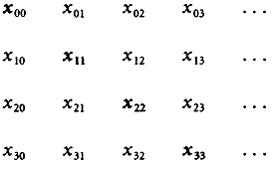diagonal — procedure … Philosophy dictionary
diagonal argument — diagonal procedure … Philosophy dictionary
Cantor , Georg Ferdinand Ludwig Philipp — (1845–1918) German mathematician The son of a prosperous merchant of St. Petersburg, at that time the capital of Russia, Cantor was educated at the University of Berlin where he completed his PhD in 1868. In 1870 he joined the faculty of the… … Scientists
List of philosophy topics (D-H) — DDaDai Zhen Pierre d Ailly Jean Le Rond d Alembert John Damascene Damascius John of Damascus Peter Damian Danish philosophy Dante Alighieri Arthur Danto Arthur C. Danto Arthur Coleman Danto dao Daodejing Daoism Daoist philosophy Charles Darwin… … Wikipedia
mathematics — /math euh mat iks/, n. 1. (used with a sing. v.) the systematic treatment of magnitude, relationships between figures and forms, and relations between quantities expressed symbolically. 2. (used with a sing. or pl. v.) mathematical procedures,… … Universalium
Algorithme De Tracé De Segment De Bresenham — L’algorithme de tracé de segment de Bresenham est un algorithme développé par Bresenham en mai 1962, alors qu’il travaillait dans un laboratoire informatique d’IBM et cherchait à piloter un traceur attaché à une console texte. Cet algorithme a… … Wikipédia en Français
Algorithme de trace de segment de Bresenham — Algorithme de tracé de segment de Bresenham L’algorithme de tracé de segment de Bresenham est un algorithme développé par Bresenham en mai 1962, alors qu’il travaillait dans un laboratoire informatique d’IBM et cherchait à piloter un traceur… … Wikipédia en Français
Algorithme de tracé de segment de Bresenham — L’algorithme de tracé de segment de Bresenham est un algorithme développé par Bresenham en mai 1962, alors qu’il travaillait dans un laboratoire informatique d’IBM et cherchait à piloter un traceur attaché à une console texte. Cet algorithme a… … Wikipédia en Français
Algorithme de tracé de segment de bresenham — L’algorithme de tracé de segment de Bresenham est un algorithme développé par Bresenham en mai 1962, alors qu’il travaillait dans un laboratoire informatique d’IBM et cherchait à piloter un traceur attaché à une console texte. Cet algorithme a… … Wikipédia en Français
Jacobi eigenvalue algorithm — The Jacobi eigenvalue algorithm is a numerical procedure for the calculation of all eigenvalues and eigenvectors of a real symmetric matrix. Description Let varphi in mathbb{R}, , 1 le k < l le n and let J(varphi, k, l) denote the n imes n matrix … Wikipedia
 We then consider the diagonal (highlighted) real x 00 x 11 x 22…and define a non-terminating decimal that differs in each place: e.g. let y nn = 5 if x nn ? 5, and y nn = 6 otherwise. This then is a real that was not on the original list, for it differs from the nth real on the list in the nth place. The construction refutes the thesis that we had enumerated all the reals. Diagonal arguments are one of the most powerful tools of set theory and metamathematics . They also bear a close relationship to arguments of the Liar family: an explicit use of diagonal reasoning occurs in Richard's paradox.
We then consider the diagonal (highlighted) real x 00 x 11 x 22…and define a non-terminating decimal that differs in each place: e.g. let y nn = 5 if x nn ? 5, and y nn = 6 otherwise. This then is a real that was not on the original list, for it differs from the nth real on the list in the nth place. The construction refutes the thesis that we had enumerated all the reals. Diagonal arguments are one of the most powerful tools of set theory and metamathematics . They also bear a close relationship to arguments of the Liar family: an explicit use of diagonal reasoning occurs in Richard's paradox.